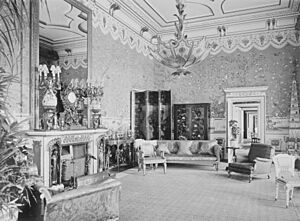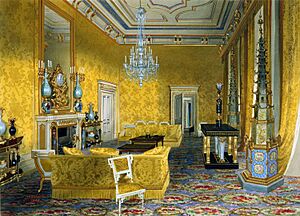Yellow Drawing Room facts for kids
The Yellow Drawing Room is a beautiful and important room inside Buckingham Palace in London. It's famous for its special "Chinoiserie" style, which means its decorations are inspired by Chinese art and designs. This room has also been the background for many famous portraits of members of the British royal family.
Contents
Exploring the Yellow Drawing Room
Where is This Special Room?
The Yellow Drawing Room is located on the first floor of Buckingham Palace. You can find it at the far west end of a long hallway called the Great Gallery. From its windows, you can look out over the palace's front courtyard. This room was created in the 1840s when Edward Blore was working on expanding the palace.
At the other end of the Great Gallery is the Chinese Luncheon Room, with the Centre Room in between. The Yellow Drawing Room also connects to a group of bedrooms and dressing rooms used by important guests staying at the palace. The room got its name because in the 1800s, it was decorated with lovely yellow, or "amber-coloured," satin fabric. The room is quite tall, about 32 feet high, and is shaped like a square.
Some items from the Yellow Drawing Room were temporarily moved to the Royal Pavilion in Brighton for two years starting in September 2019. These pieces were originally bought by George IV and placed in the Royal Pavilion a long time ago. They were moved back to the palace after the loan period.
What Makes It So Special? Its Decorations!
In the 1840s, people described the Yellow Drawing Room as one of the most magnificent rooms in the palace. It was decorated with large portraits of the royal family painted directly onto the walls. The room also featured beautiful sculptures called "reliefs" by an artist named William Pitts. These reliefs showed a series of scenes about "the origin and progress of pleasure."
The grand light fixture, called a chandelier, in the Yellow Drawing Room used to hang in the Music Room of the Royal Pavilion.
In 1855, the room was redecorated with yellow silk for a special visit from the French Emperor Napoleon III and his wife, Empress Eugénie. They stayed at Buckingham Palace for three days, and the Yellow Drawing Room was used as the Emperor's reception room. Some people thought the mix of new yellow decorations and the older Chinese-style furniture looked a bit unusual, but it added to the room's unique charm.
The Amazing Chinoiserie Style
The Yellow Drawing Room is filled with many objects that show off the "Chinoiserie" style. This style was created by Frederick Crace for the Royal Pavilion in Brighton. The Centre Room and Chinese Drawing Room in Buckingham Palace also have similar decorations. These special pieces were brought to Buckingham Palace after the Royal Pavilion was sold in 1850. Prince Albert, Queen Victoria's husband, helped arrange for them to be used in the palace rooms.
The wallpaper in the Yellow Drawing Room is very old and special. It was first made in 1817 for the Royal Pavilion, ordered by George IV. It was rediscovered in the palace much later and was hung in the Yellow Drawing Room when Queen Mary redecorated the room in the 1920s. The wallpaper was carefully removed for cleaning and repair in 2020. This process took about a month, and now the wallpaper is expected to last for another 100 years without needing more care! The wallpaper shows a beautiful Chinese garden with colorful birds, butterflies, fruit trees, and bushes. It has two decorative borders: the top one shows tall green jars and hanging baskets with magnolias and peonies, while the bottom border features wading birds and tall lotus plants.
The room also has a unique fireplace, called a chimney piece, in the Chinese style. It came from the Royal Pavilion and was made in 1822 by Samuel Parker, designed by Robert Jones. It features figures of "nodding mandarins" (which are figures of old Chinese officials) wearing shiny metal clothes in little alcoves. It also has fierce-looking winged "ormolu" dragons. Ormolu is a type of gilded bronze, which means it's bronze covered in a thin layer of gold. The Chinese "celadon" candelabras (candle holders) on the fireplace also came from the Royal Pavilion. Celadon is a beautiful green-grey glaze used on pottery. The top part of the fireplace shows two snakes moving towards a sunflower, with two winged dragons climbing the metal columns that hold up the mantelpiece.
The interesting "Rock Clock" on the fireplace was originally in the Music Room of the Royal Pavilion. Its design is thought to be by Sébastien Slodtz. It shows a dragon being attacked by Mars, the Roman god of war, who is wrapped around a rock and a palm tree. Juno, a Roman goddess, sits on top of the clock face, and Cupid is shown hugging a peacock.
A pair of tables in the chinoiserie style stand on either side of the fireplace. One of these tables is French and dates back to around 1780; it was once in the Chinese Room at Carlton House. The other table is English and is a copy of the French one. It was made in 1819 for the Music Room Gallery at the Royal Pavilion. There are also chairs in the room made by Bailey & Sanders that were originally in the Banqueting Room Gallery at the pavilion.
The room is also home to a pair of Chinese "pagodas" made of porcelain. Pagodas are tower-like structures often found in East Asian architecture. These pagodas sit on bases made by Spode, a famous pottery company. They are placed on either side of a table with a "pietra dura" top. Pietra dura is a special way of decorating using finely cut and fitted colored stones to create pictures. This table was originally made for the Crimson Drawing Room at Windsor Castle. Another matching pair of pagodas was seen in a different part of Buckingham Palace in the 1930s.
A Favorite Spot for Royal Portraits
The Yellow Drawing Room has been a popular place for many artists to paint or photograph members of the British royal family.
In 1953, artist Terence Cuneo was taking pictures of a four-year-old Prince Charles in the Yellow Drawing Room. This was to help him prepare for the official portrait of Queen Elizabeth II's coronation. Prince Charles, being curious, asked if he could photograph Cuneo! Cuneo lifted him onto a 9-foot ladder so he could take a picture, which surprised both Cuneo and Charles's nurse.
Bryan Organ used the room as the setting for his portrait of Diana, Princess of Wales in 1981. Justin Mortimer's abstract portrait of The Queen was painted in 1997.
The light artist Chris Levine took 10,000 pictures of Queen Elizabeth II in the Yellow Drawing Room over two sittings to create his 2004 hologram called Equanimity. This was the very first 3D holographic portrait of the Queen!
Prince Philip, Duke of Edinburgh posed in the room for his 2012 portrait by painter Jemma Phipps. Darren Baker's 2011 portrait of the Queen in the Yellow Drawing Room was created to celebrate the 90th anniversary of the Royal British Legion. In this painting, the Queen is shown wearing five remembrance poppies and her wristwatch shows 11 am, symbolizing the armistice that ended World War I.



